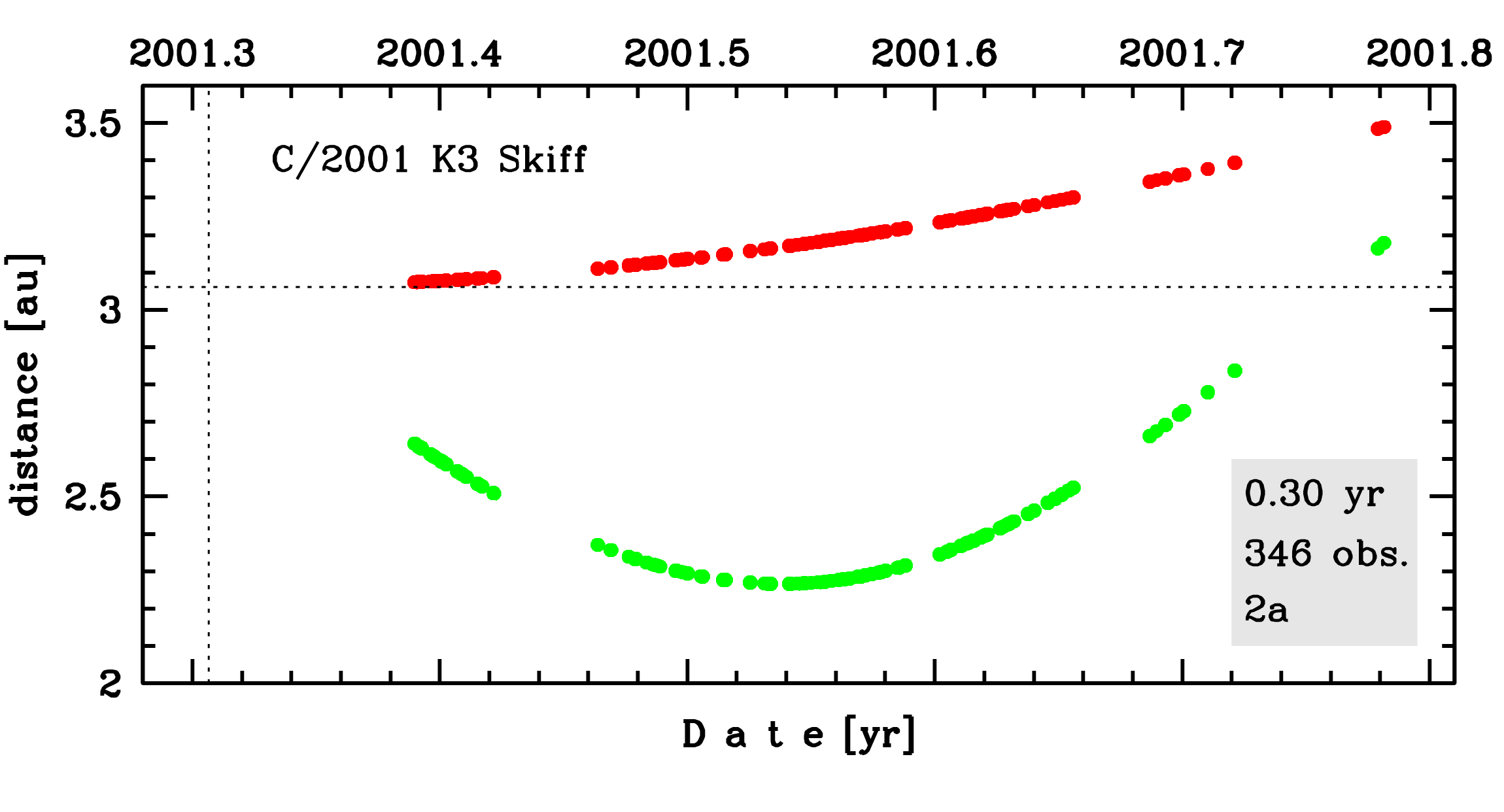C/2001 K3 Skiff
more info
Comet C/2001 K3 was discovered on 22 May 2001 by Brian A. Skiff during LONEOS project, that is a month after its perihelion passage. It was observed until 12 October 2001.
Comet had its closest approach to the Earth on 15 July 2001 (2.266 au), less than 2 months after discovery.
Solution given here is based on data spanning over 0.392 yr in a range of heliocentric distances from 3.07 au to 3.49 au.
This Oort spike comet suffers notable planetary perturbations during its passage through the planetary system; these perturbations lead to a significantly more tight future orbit with semimajor axis of about 1,500 au.
See also Królikowska 2014.
Comet had its closest approach to the Earth on 15 July 2001 (2.266 au), less than 2 months after discovery.
Solution given here is based on data spanning over 0.392 yr in a range of heliocentric distances from 3.07 au to 3.49 au.
This Oort spike comet suffers notable planetary perturbations during its passage through the planetary system; these perturbations lead to a significantly more tight future orbit with semimajor axis of about 1,500 au.
See also Królikowska 2014.
| solution description | ||
|---|---|---|
| number of observations | 346 | |
| data interval | 2001 05 22 – 2001 10 12 | |
| data type | observed only after perihelion (POST) | |
| data arc selection | entire data set (STD) | |
| range of heliocentric distances | 3.07 au – 3.49au | |
| detectability of NG effects in the comet's motion | NG effects not determinable | |
| type of model of motion | GR - gravitational orbit | |
| data weighting | YES | |
| number of residuals | 669 | |
| RMS [arcseconds] | 0.67 | |
| orbit quality class | 2a | |
| next orbit statistics, both Galactic and stellar perturbations were taken into account | ||
|---|---|---|
| no. of returning VCs in the swarm | 5001 | * |
| no. of escaping VCs in the swarm | 0 | |
| no. of hyperbolas among escaping VCs in the swarm | 0 | |
| next reciprocal semi-major axis [10-6 au-1] | 657.00 – 665.70 – 674.35 | |
| next perihelion distance [au] | 3.06355 – 3.06365 – 3.06375 | |
| next aphelion distance [103 au] | 2.96 – 3 – 3.04 | |
| time interval to next perihelion [Myr] | 0.0568 – 0.0579 – 0.0591 | |
| percentage of VCs with qnext < 10 | 100 | |
| next_g orbit statistics, here only the Galactic tide has been included | ||
|---|---|---|
| no. of returning VCs in the swarm | 5001 | * |
| no. of escaping VCs in the swarm | 0 | |
| no. of hyperbolas among escaping VCs in the swarm | 0 | |
| next reciprocal semi-major axis [10-6 au-1] | 657.00 – 665.69 – 674.35 | |
| next perihelion distance [au] | 3.06093 – 3.06094 – 3.06095 | |
| next aphelion distance [103 au] | 2.96 – 3 – 3.04 | |
| time interval to next perihelion [Myr] | 0.0568 – 0.0579 – 0.059 | |
| percentage of VCs with qnext < 10 | 100 | |
